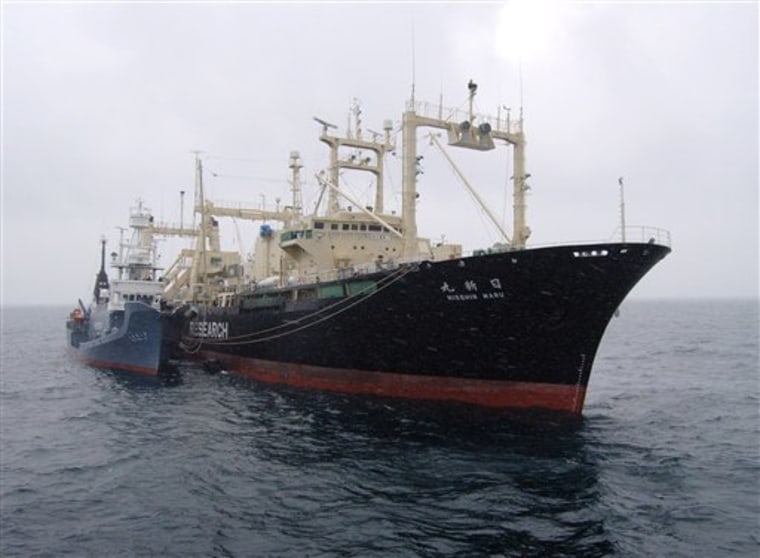A whaling ship disabled by fire in Antarctic waters near the world’s biggest penguin breeding ground poses no environmental threat, Japanese officials said Friday, despite calls for swift action to avert catastrophe.
New Zealand officials and environmentalists expressed concern that the 8,000-ton Nisshin Maru — left without engine power after a fire broke out aboard — could threaten the penguin rookery at Cape Adare, about 100 miles away.
It is unclear if the fire has been extinguished; officials said Friday that the area where the fire broke out was filled with smoke and couldn’t be examined.
The ship is carrying tens of thousands of gallons of oil, which environmentalists fear will spill and be carried by currents to Cape Adare. But no oil had spilled and the vessel was in no immediate danger of sinking, officials said.
One crewman is missing and presumed dead.
Japanese government-affiliated Institute of Cetacean Research Director General Hiroshi Hatanaka said the ship poses no danger to the environment.
'Premature' fears
“Fears that this might turn into some environmental disaster are premature. The vessel is not drifting, its not listing and its not leaking,” he said. “The area in which the fire broke out is not located near the fuel holds.”
Japanese officials said they may have to abandon this season’s whale hunt in the ice-strewn waters of the Southern Ocean because of the fire. While there are other whaling ships nearby, the Nisshin Maru is the only ship in the fleet able to process whale carcasses.
Conservation Minister Chris Carter of New Zealand, an anti-whaling nation that also has responsibility for maritime rescues in the area, urged the Japanese government to use either the Greenpeace ship Esperanza — a converted Russian tug — or a U.S. icebreaker in the area to move the vessel.
“It is imperative the Nisshin Maru is towed further away from the pristine Antarctic coast, the neighboring penguin colony and the perilous ice floes,” Carter said. “It’s likely we have two days of good weather to move the Nisshin Maru out of Antarctic waters in the safest and most practical way.”
Greenpeace said it was willing and able to help, and the Esperanza — in the region to try to stop the whale hunt — could reach the stricken ship in about 24 hours. “We have the capacity and we’re on the spot,” Greenpeace spokeswoman Cindy Baxter said.
Greenpeace offer rejected
Glenn Inwood, spokesman for the Institute of Cetacean Research, said no help was needed. “The whole Greenpeace offer is a red herring. Their assistance is not required and will not be accepted,” he told The Associated Press.
Whaling ship the Oriental Bluebird was alongside the Nisshin Maru and “fully able” to tow it out of the area if required, Inwood said.
“The main priority is to locate the missing sailor, clear the smoke then decide whether to move the Nisshin Maru or repair it on the spot — if that’s possible,” he said.
Crew went below decks on Friday and set up fans to try to cool the burned-out part of the ship and blow out dense smoke that has filled the vessel since the blaze broke out early Thursday.
The whaling fleet had planned to hunt up to 945 whales from mid-December to mid-March. It was not immediately known how many whales have been killed so far.
“Whether we can complete the hunt would depend on the extent of damage to the ship,” said Hajime Ishikawa, another official at the institute. “But it would be difficult to continue if the ship has to be brought into port.”
Japan says its annual whale hunts, begun after the International Whaling Commission imposed a global ban on commercial whaling in 1986, are for research. Environmental groups say the hunts are a pretext to keep Japan’s tiny whaling industry alive.
Carter, whose country is leading efforts to help the stricken ship, said it was carrying 132,000 gallons of heavy oil and 211,000 gallons of furnace oil and was starting to list from water pumped aboard to fight the fire.
"It is a serious situation ... a ship badly damaged and full of toxic oil," Carter told National Radio on Thursday.
Carter noted the ship was only 110 miles from the Antarctic's Cape Adare, one of the world's largest penguin breeding rookeries with some 250,000 breeding pairs, Antarctica New Zealand chief executive Lou Sanson said.
"It's a long way off the coast but the currents do go that way. We're very concerned about what could happen," Sanson told The Associated Press.
Chased by activists earlier
The Nisshin Maru was the flagship of a Japanese whaling flotilla harassed this month by activists from the conservation group Sea Shepherd, who have thrown foul-smelling acid and other objects at the ships to try to keep them from hunting whales.
A Sea Shepherd ship collided with a Japanese ship earlier in recent days, causing damage but no injuries.
Sea Shepherd on Wednesday gave up its chase as it started to run out of fuel.
